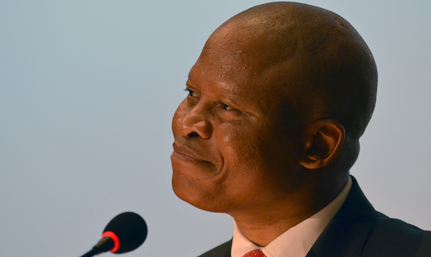|

|
|
Our Faculty of Law brought together top experts and judges for a Symposium on Corruption, to investigate one of the most pressing concerns of South Africans.
Photo: Stephen Collett
24 January 2013 |
Chief Justice Mogoeng Mogoeng yesterday (24 January 2013) concluded the proceedings of the first day of the International Symposium on Corruption, hosted by the Faculty of Law of the University of the Free State (UFS). In his address Justice Mogoeng made no excuses as to the magnitude of the threat corruption presents to South African citizens.
“Urgent action and efficient measures are called for to arrest this scourge, for the sake of our constitutional democracy,” he warned. “Our vibrant constitutional democracy will not and cannot survive in the face of rampant corruption.”
Justice Mogoeng said the spate of civil and labour unrest erupting throughout the country can be attributed to corruption. According to him the scope and far-reaching implications of corruption drives South Africans to “boiling point” and evokes “anger, frustration and a don’t-care-attitude that often manifests in widespread protest actions” and disrespect for the rule of law.
“South Africans, irrespective of race or creed, must identify and focus on their common enemies and find a conciliatory and unifying way of dealing with what divides them, including the lingering prejudices of the past,” Justice Mogoeng urged.
Despite the threat corruption poses, he stressed that all South Africans have a role to play in the fight against corruption and that there are different role players that can become involved in the process. Especially important is the media and faith-based agencies which, according to Justice Mogoeng, can regenerate morals and secure a “national moral code.” The State must further ensure enforcement of anti-corruption measures and preside over the selection of individuals of “solid character” to reside in agencies meant to fight corruption.
He highlighted the need for an unbiased and independent judiciary, one immune to outside influences controlled by powerful forces, as well as personal agendas.
Although Justice Mogoeng believes that the private sector is most guilty of transgressions based on corruption, he stated that a “well-coordinated war” against it must be waged in all sectors in order to stamp it out.
Justice Mogoeng presided over the unveiling of the redesigned foyer of the CR Swart Building and praised the Faculty of Law for its innovation with regard to the symposium.
“I look forward with great optimism to more well-organised symposiums that strike at the nerve-centre of the well-being of our constitutional democracy,” he concluded.
Symposium seeks answers and solutions
The Faculty of Law at the University of the Free State (UFS) concluded its International Symposium on Corruption on Friday 25 January 2013. The event featured a stellar cast of speakers, including the Chief Justice of South Africa, three current Supreme Court of Appeal judges, high-court judges, advocates, prosecutors, journalists, as well as local and international legal academics.
Throughout the two-day symposium, corruption was dissected as a severe problem in the South African socio-economic landscape and solutions were sought to alleviate the pressing concern.
The main attractions of the symposium were undoubtedly the attendance and presentations delivered by Chief Justice Mogoeng Mogoeng, as well as Prof. Leon Wessels. Prof. Wessels was described as “one of the founding fathers of the constitution of South Africa” by Judge Fritz Brand, a current Appeal Court judge and the third-longest serving judge in the country.
“Corruption is stealing the constitutional dream of this country. Corrupt leaders are fearless, those who expose corruption, are fearful,” Prof. Wessels warned.
Judge Brand closely trails the second longest serving judge in the country in former Kovsie, as well as former UFS Council Chairman, Judge Faan Hancke. Both judges addressed the symposium and chaired sessions, along with Prof. Johan Henning, Dean of the Faculty of Law, and Judge Ian van der Merwe, Chairman of the UFS Council.
It was, however, not all doom and gloom, as several of the speakers offered tangible ideas in what was often termed the “war on corruption”. Celebrated Sunday Times journalist Mzilikazi wa Afrika who has been arrested following the police leasing scandal which he exposed, urged South Africans to stand together in their fight against corruption, before it is too late.
People on the front lines in the day to day fight against corruption also spoke at the symposium, giving the audience a better understanding of the intricacies and challenges involved in the process. The Head of the National Prosecuting Authority’s Asset Forfeiture Unit, Mr Willie Hofmeyer, as well as Advocate Xolisile Khanyile, who is the Director of Public Prosecutions in the Free State, elucidated this struggle.
The symposium also hosted Prof. Chizu Makajima, a celebrated academic from the United Kingdom.
The two-day symposium ended in style as the delegates gathered in the Centenary Hall on the Bloemfontein Campus for lunch, with a further address by Prof. Leon Wessels